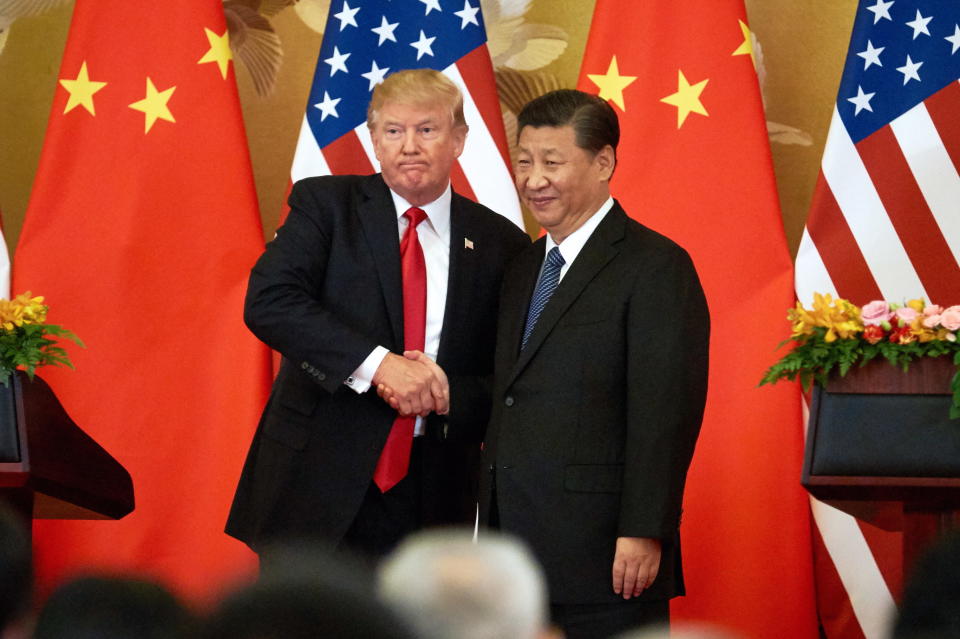The U.S. has a secret weapon in the trade war
As trade tensions run hot between the U.S. and China, President Trump might have one key advantage in the trade war, according to Nomura.
Analyst Romit Shah explained that China’s dependence on U.S.-made advanced microchips could give Trump the upper hand.
“We believe that as China-U.S. tensions escalate, U.S. semiconductors give Washington a strong hand because the core components of Made in China 2025 (AI, smart factories, 5G, bigdata and full self-driving electric vehicles) can’t happen without advanced microchips from the U.S.,” Shah said in a note to clients.

Made in China 2025 is the Chinese government’s 10-year plan to update the country’s 10 high-tech manufacturing industries, which include information technology, robotics, aerospace, rail transport, and new-energy vehicles, among others.
One of Made in China 2025’s main goals is to become semiconductor self sufficient. China hopes that at least 40% of the semiconductors used in China will be made locally by 2020, and at least 70% by 2025. “Made in China 2025 made abundantly clear China’s commitment to semiconductor self-sufficiency. Made in China 2025 will upgrade multiple facets of the Chinese economy,” Shah said.
According to Nomura’s estimates, China is currently about 3 to 5 years behind the U.S. in dynamic random-access memory (DRAM) chip production. However, Shah explained that if the trade war persists, the consequences could set Chinese chip production behind by 5 to 15 years.
Without U.S. semis, China will not be able to process the technology necessary to push forward the Made in China 2025 program. “American chips in many ways form the backbone of China’s tech economy,” Shah said.
Consequences for U.S.
The Trump Administration’s tariffs on Chinese goods were intended to severely disrupt the Chinese tech-advancement initiative. But Shah says that making U.S. chips more expensive for China could have consequences for the U.S. as well.
One concern centers around intellectual property theft. The Department of Justice (DOJ) has been working hard to punish China for allegedly attempting to commit espionage. For example, the DOJ believes China was attempting to spy on the U.S. through Huawei and asked U.S. allies to drop the Chinese tech equipment maker.
However, while many U.S. chipmakers, such as Advanced Micro Devices (AMD), Qualcomm (QCOM) and Micron (MU), expressed gratitude that the DOJ was intervening to prevent intellectual property theft, the companies are also concerned that it could spark retaliation from their Chinese business partners and result in loss of access to the Chinese market. “Joint ventures, IP sharing agreements and manufacturing partnerships are the price of admission into China, and thus far, companies are playing ball,” Shah explained.
Shah essentially calls the Chinese tariffs a double-edged sword. While tariffs will hurt the Chinese if they can’t have access to freely source U.S. chips, it could also hurt U.S. chipmakers if they lose their business in China. According to Shah’s research, “Over 50% of Chinese semiconductor consumption is supplied by U.S. firms … In 2017, China consumed $138bn in integrated circuits (ICs), of which it only produced $18.5bn domestically, implying China imported $120bn of semis in 2017, up from $98bn in 2016 and $73bn in 2012.”
Trump and China’s President Xi Jinping are scheduled to meet at the G20 summit in Buenos Aires, Argentina, on Thursday for a two-day meeting. If the two leaders are unable to come to some sort of trade resolution at the meeting, U.S. tariffs on over $200 billion worth of Chinese goods will increase from 10% to 25% on January 1, 2019.
“China could source equipment from Europe and Japan; however, we believe there are certain mission-critical tools that can only be purchased from the U.S. … We believe that U.S.-China trade is the biggest theme for U.S. semis and equipment stocks in 2019. Made in China 2025 can’t happen without U.S. semis, and U.S. semis can’t grow without China. We hope this backdrop drives resolution,” Shah said.
Heidi Chung is a reporter at Yahoo Finance. Follow her on Twitter: @heidi_chung.
Follow Yahoo Finance on Twitter, Facebook, Instagram, Flipboard, LinkedIn, and reddit.
More from Heidi:
Trump slams Fed Chair Powell, says he’s ‘not even a little bit happy’ with him
Trade uncertainty is ‘squelching business investments,’ JPMorgan strategist says


